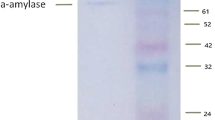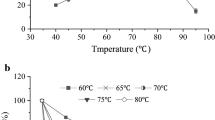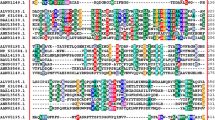Abstract
Enzymes are highly complex systems with a substantial degree of structural variability in their folded state. In the presence of cosolvents, fluctuations among vast numbers of folded and unfolded conformations occur via many different pathways; alternatively, certain conformations can be stabilized or destabilized. To understand the contribution of osmolytes to the stabilization of structural changes and enzymatic activity of a truncated Bacillus sp. TS-23 α-amylase (BACΔNC), we monitored amylolytic activity, circular dichroism, and fluorescence as a function of osmolytes. In the presence of trimethylamine N-oxide (TMAO) and sorbitol, BACΔNC activity was retained significantly at elevated temperatures. As compared to the control, the secondary structures of this enzyme were essentially conserved upon the addition of these two kinds of osmolytes. Fluorescence results revealed that the temperature-induced conformational change of BACΔNC was prevented by TMAO and sorbitol. However, glycerol did not provide profound protection against thermal denaturation of the enzyme. Sorbitol was further found to counteract guanidine hydrochloride- and SDS-induced denaturation of BACΔNC. Thus, some well-known naturally occurring osmolytes make a dominant contribution to the stabilization of BACΔNC.





Similar content being viewed by others
References
Attri P, Venkatesu P, Lee MJ (2010) Influence of osmolytes and denaturants on the structure and enzyme activity of α-chymotrypsin. J Phys Chem B 114:1471–1478
Auton M, Ferreon ACM, Bolen DW (2006) Metrics that differentiate the origins of osmolyte effects on protein stability. J Mol Biol 361:983–992
Back JF, Oakenfull D, Smith MB (1979) Increased thermal stability of proteins in the presence of sugars and polyols. Biochemistry 18:5191–5199
Bia C, Biwersi J, Verkman AS, Matthay MA (1998) A mouse model to test the in vivo efficacy of chemical chaperones. J Pharmacol Toxicol Methods 40:39–45
Bolen DW (2001) Protein stabilization by naturally occurring osmolytes. Methods Mol Biol 168:17–36
Bolen DW, Baskakov IV (2001) The osmophobic effect: natural selection of a thermodynamic force in protein folding. J Mol Biol 310:955–963
Bolen DW, Rose GD (2008) Structure and energetics of the hydrogen-bonded backbone in protein folding. Annu Rev Biochem 77:339–362
Brady D, Jordann J (2009) Advances in enzyme immobilisation. Biotechnol Lett 31:1639–1650
Broeriug JM, Bommarius AS (2007) Cation and strong cosolute effects on protein kinetic stability. Biochem Soc Trans 35:1602–1605
Burg M, Kwan EG, Peters E (1996) Glycerophosphocholine and betaine counteract the effect of urea on pyruvate kinase. Kidney Int 50(suppl 57):S100–S104
Burrows JA, Willis LK, Perlmutter DH (2000) Chemical chaperones mediate increased secretion of mutant alpha 1-anti-trypsin (alpha 1-AT) Z: a potential pharmacological strategy for prevention of liver injury and emphysema in alpha 1-AT deficiency. Proc Natl Acad Sci USA 97:1796–1801
Chi MC, Chen YH, Wu TJ, Lo HF, Lin LL (2010) Engineering of a truncated α-amylase of Bacillus sp. strain TS-23 for the simultaneous improvement of thermal and oxidative stabilities. J Biosci Bioeng 109:531–538
Chi MC, Wu TJ, Chuang TT, Chen HL, Lo HF, Lin LL (2010) Biophysical characterization of a recombinant α-amylase from thermophilic Bacillus sp. strain TS-23. Protein J 29:572–582
Fujinami S, Fujisawa M (2010) Industrial applications of alkaliphiles and their enzymes—past, present and future. Environ Technol 31:845–856
Gekko K, Koga S (1983) Increased thermal stability of collagen in the presence of sugars and polyols. J Biochem (Tokyo) 94:199–208
Ghumman B, Bertram EM, Watts TH (1998) Chemical chaperones enhance superantigen and conventional antigen presentation by HLA-DM-deficient as well as HLA-DM-sufficient antigen-presenting cells and enhance IgG2a production in vivo. J Immunol 161:3262–3270
Gupta R, Gigras P, Mohapatra H, Goswami VK, Chauhan B (2003) Microbial α-amylases: a biotechnological perspective. Process Biochem 38:1599–1616
Guzman-Maldonado H, Paredes-Lopez O (1995) Amylolytic enzymes and products derived from starch: a review. Crit Rev Food Sci Nutr 35:373–403
Isom DG, Cannon BR, Costañeda CA, Robinson A, García-Moreno B (2008) High tolerance for ionizable residues in the hydrophobic interior of proteins. Proc Natl Acad Sci USA 105:17784–17788
Ito S, Kobayashi T, Ara K, Ozaki K, Kawai S, Hatada Y (1998) Alkaline detergent enzymes from alkaliphiles: enzymatic properties, genetics, and structures. Extremophiles 2:185–190
Jäckel C, Hilvert D (2010) Biocatalysts by evolution. Curr Opin Biotechnol 21:753–759
Jacnicke R (1991) Protein stability and molecular adaptation to extreme conditions. Eur J Biochem 202:715–728
Kim SH, Zhou HM, Yan YB (2007) Effects of hydroxypropyl cyclodextrins on the reactivation of SDS-denatured aminoacylase. Int J Biol Macromol 40:76–82
Kim YS, Jones LS, Dong A, Kendrick BS, Chang BS, Manning MC, Randolph TW, Carpenter JF (2003) Effects of sucrose on conformational equilibria and fluctuations within the native-state ensemble of proteins. Protein Sci 12:1252–1261
Kubrak OI, Lushchak VI (2007) Microbe amylases: characteristic, properties and practical use. Mikrobiol Z 69:56–76
Lin LL, Tsau MR, Chu WS (1997) A gene encoding for an α-amylase from thermophilic Bacillus sp. strain TS-23 and its expression in Escherichia coli. J Appl Microbiol 82:325–334
Lin TY, Timasheff SN (1993) Why do some organisms use a urea-methylamine mixture as osmolyte? Thermodynamic compensation of urea and trimethylamine N-oxide interactions with protein. Biochemistry 33:12695–12701
Liu Y, Bolen DW (1995) The peptide backbone plays a dominant role in protein stabilization by naturally occurring osmolytes. Biochemistry 34:12884–12891
Lo FH, Lin LL, Chen SL, Hsu WH, Chang CT (2001) Enzymatic properties of a SDS-resistant Bacillus sp. TS-23 α-amylase produced by recombinant Escherichia coli. Process Biochem 36:743–750
Lo FH, Lin LL, Chiang WY, Chi MC, Hsu WH, Chang CT (2002) Deletion analysis of the C-terminal region of the α-amylase of Bacillus sp. strain TS-23. Arch Microbiol 178:115–123
Lo FH, Lin LL, Li CC, Hsu WH, Chang CT (2001) The N-terminal signal sequence and the last 98 amino acids are not essential for the secretion of Bacillus sp. TS-23 α-amylase in Escherichia coli. Curr Microbiol 43:170–175
Mandal AK, Samaddar S, Banerjee R, Lahiri S, Bhattacharyya A, Roy S (2003) Glutamate counteracts the denaturing effect of urea through its effect on the denatured state. J Biol Chem 278:36077–36084
Manning M, Colon W (2004) Structural basis of protein kinetic stability: resistance to sodium dodecyl sulfate suggests a central role for rigidity and a bias toward β-sheet structure. Biochemistry 43:11248–11254
Miller GL (1959) Use of dinitrosalicylic acid reagent for determination of reducing sugars. Anal Chem 31:426–428
Moniruzzaman M, Kamiya N, Goto M (2010) Activation and stabilization of enzymes in ionic liquids. Org Biomol Chem 8:2887–2899
Mozhaev VV (1993) Mechanism-based strategies for protein thermostabilization. Trends Biotechnol 11:88–95
Mu H, Zhou SM, Xia Y, Zou H, Meng F, Yan YB (2009) Inactivation and unfolding of the hyperthermophilic inorganic pyrophosphatase from Thermus thermophilus by sodium dodecyl sulfate. Int J Mol Sci 10:2849–2859
Nakajima R, Imanaka T, Aiba S (1985) Nucleotide sequence of the Bacillus stearothermophilus α-amylase gene. J Bacteriol 163:401–406
Nennion BJ, Daggett V (2003) The molecular basis for the chemical denaturation of proteins by urea. Proc Natl Acad Sci USA 100:5142–5147
Otzen DE, Oliveberg M (2002) Burst-phase expansion of native protein prior to global unfolding in SDS. J Mol Biol 315:1231–1240
Pandey A, Nigam P, Soccol CR, Soccol VT, Singh D, Mohan R (2000) Advances in microbial α-amylases. Biotechnol Appl Biochem 31:135–152
Plaza-del-Pino IM, Sanchez-Ruiz JM (1995) An osmolyte effect on the heat capacity change for protein folding. Biochemistry 34:8621–8630
Prakash O, Jaiswal N (2010) α-Amylase: an ideal representative of thermostable enzymes. Appl Biochem Biotechnol 160:2401–2414
Royer CA, Mann CJ, Matthews CR (1993) Resolution of the fluorescence equilibrium unfolding profile of trp aporepressor using single tryptophan mutants. Protein Sci 2:1844–1852
Sawangwan T, Goedi C, Nidetzky B (2010) Glucosylglycerol and glucosylglycerate as enzyme stabilizers. Biotechnol J 5:187–191
Sathish HA, Kumar PR, Prakash V (2007) Mechanism of solvent induced thermal stabilization of papain. Int J Biol Macromol 41:383–390
Schein CH (1990) Solubility as a function of protein structure and solvent components. Biotechnology 8:308–317
Schellman JA (2002) Fifty years of solvent denaturation. Biophys Chem 96:91–101
Somero GN (2004) Adaptation of enzymes to temperature: searching for basic “strategies”. Comp Biochem Physiol B Biochem Mol Biol 39:321–333
Souza PM, Magalhāes PO (2010) Application of microbial α-amylase in industry—a review. Braz J Microbiol 41:850–861
Stanley C, Rau DC (2008) Measuring the interaction of urea and protein stabilizing osmolytes with the nonpolar surface of hydroxypropyl cellulose. Biochemistry 47:6711–6718
Strambini GB, Gonnelli M (2008) Singular efficacy of trimethylamine N-oxide to counter protein destabilization in ice. Biochemistry 47:3322–3323
Street TO, Bolen DW, Rose GD (2006) A molecular mechanism for osmolyte-induced protein stability. Proc Natl Acad Sci USA 103:13397–14002
Takano K, Saito M, Morikawa M, Kanaya S (2004) Mutational and structural-based analyses of the osmolyte effect on protein stability. J Biochem (Tokyo) 135:701–708
Tams JW, Welinder KG (1996) Unfolding and refolding of Coprinus cinereus peroxidase at high pH, in urea and at high temperature: effect of organic and ionic additives on these processes. Biochemistry 35:7573–7579
Timasheff SN (1993) The control of protein stability and association by weak interactions with water: how do solvents affect these processes? Annu Rev Biophys Biomol Struct 22:67–97
Timasheff SN (2002) Protein–solvent preferential interactions, protein hydration, and modulation of biochemical reaction by solvent components. Proc Natl Acad Sci USA 99:9721–9726
Tsou CL (1995) Inactivation precedes overall molecular conformation changes during enzyme denaturation. Biochim Biophys Acta 1253:151–162
van der Maarel MJEC, van der Veen B, Uitdehaag JC, Leemhuis H, Dijkhuizen L (2002) Properties and applications of starch-converting enzymes of the α-amylase family. J Biotechnol 94:137–155
Venkatesu P, Lee MJ, Lin HM (2009) Thermodynamic characterization of the osmolyte effect on protein stability and the effect of GdnHCl on the protein denatured state. J Phys Chem B 111:9045–9056
Wang A, Bolen DW (1997) A naturally occurring protective system in urea-rich cells: mechanism of osmolyte protection of proteins against urea denaturation. Biochemistry 36:9101–9108
Xiang J, Fan JB, Chen N, Chen J, Liang Y (2006) Interaction of cellulase with sodium dodecyl sulfate at critical micelle concentration level. Colloids Surf B Biointerfaces 49:175–180
Xie GF, Timasheff SN (1997) Mechanism of the stabilization of ribonuclease A by sorbitol: preferential hydration is greater for the denatured then for the native protein. Protein Sci 6:211–221
Xu Q, Keiderling TA (2004) Effect of sodium dodecyl sulfate on folding and thermal stability of acid-denatured cytochrome c: a spectroscopic approach. Protein Sci 13:2949–2959
Yancey PH (2005) Organic osmolytes as compatible, metabolic and counteracting cytoprotectants in high osmolarity and other stresses. J Exp Biol 208:2819–2830
Yancey PH, Clarke ME, Hand SC, Bowlus RD, Somero GN (1982) Living with water stress: evolution of osmolyte systems. Science 217:1214–1222
Yang DS, Yip CM, Huang TH, Chakrabartty A, Fraser PE (1999) Manipulating the amyloid-beta aggregation pathway with chemical chaperones. J Biol Chem 274:32970–32974
Yuuki T, Nomura T, Tezuka H, Tsuboi A, Yamagata H, Tsukagoshi N, Udaka S (1985) Complete nucleotide sequence of a gene coding for heat- and pH-stable α-amylase of Bacillus licheniformis: comparison of the amino acid sequences of three bacterial liquefying α-amylases deduced from the DNA sequences. J Biochem (Tokyo) 98:1147–1156
Zancan P, Sola-Penna M (2005) Trehalose and glycerol stabilize and renature yeast inorganic pyrophosphatase inactivated by very high temperatures. Arch Biochem Biophys 444:52–60
Acknowledgments
This work was supported by a research grant (NSC 97-2628-B-415-001-MY3) from National Science Council of Taiwan.
Author information
Authors and Affiliations
Corresponding authors
Rights and permissions
About this article
Cite this article
Chi, MC., Wu, TJ., Chen, HL. et al. Sorbitol counteracts temperature- and chemical-induced denaturation of a recombinant α-amylase from alkaliphilic Bacillus sp. TS-23. J Ind Microbiol Biotechnol 39, 1779–1788 (2012). https://doi.org/10.1007/s10295-012-1183-0
Received:
Accepted:
Published:
Issue Date:
DOI: https://doi.org/10.1007/s10295-012-1183-0




